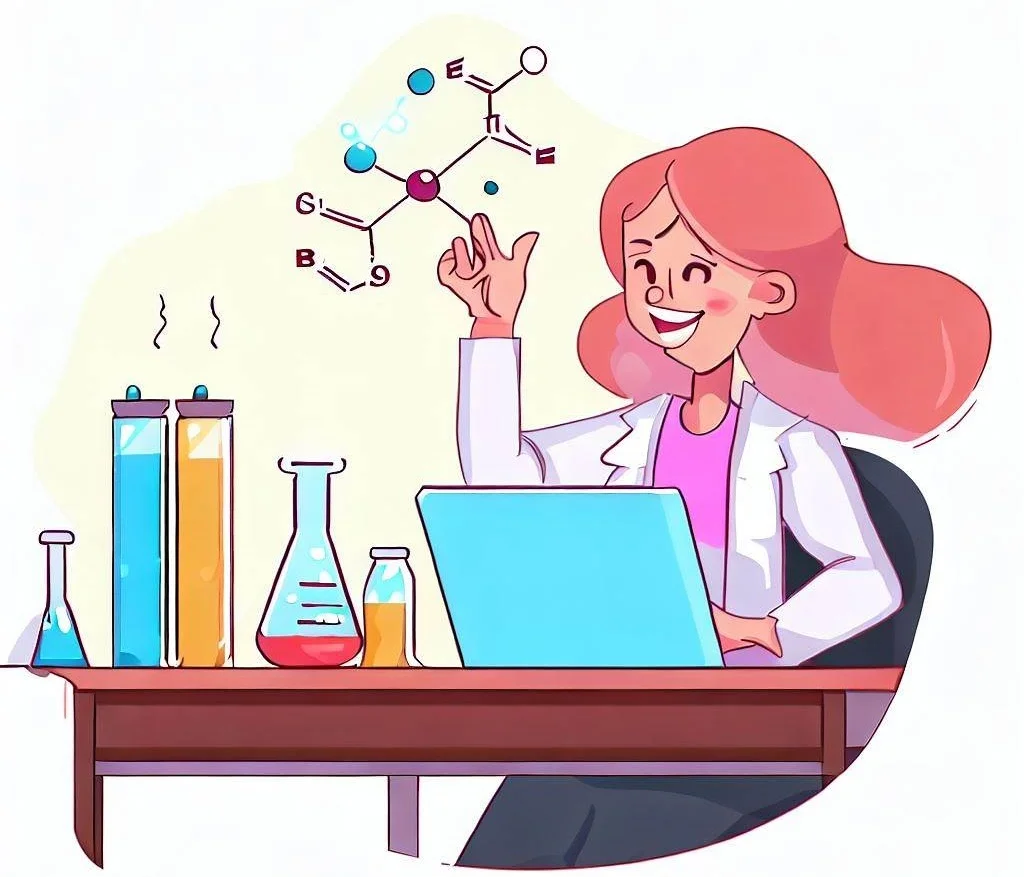Mastering Polymer Chemistry: Unraveling the Journey from Monomers to Macromolecules - An In-Depth Assignment Guide

The synthesis, structure, and characteristics of polymers, which are substantial molecules made up of repeating units called monomers, are the focus of the fascinating field of polymer chemistry. Polymers are a ubiquitous part of our lives, appearing in everything from commonplace items like plastic to cutting-edge applications in electronics and medicine. For students tackling chemistry assignments and anyone interested in this field, understanding the fundamentals of polymer chemistry is crucial. We will examine the world of polymer chemistry in great detail in this extensive manual, taking you from the complex world of monomers to the fascinating world of macromolecules. You will gain a strong foundation in polymer chemistry by understanding the ideas and guidelines presented in this manual, which will enable you to evaluate and comprehend the behavior and properties of various polymers. This handbook will serve as your compass, illuminating the complex nature of polymer chemistry, whether you are starting Polymer Chemistry Assignment, a research project, preparing for an exam, or just curious about the science behind common materials. So, let's explore the fascinating world of polymers, where small molecules combine to form remarkable macromolecules with a range of features and uses.

Understanding Monomers
Monomers are the fundamental building blocks of polymers, playing a crucial role in polymer chemistry. These small molecules possess specific chemical structures and functionalities that allow them to undergo polymerization reactions, resulting in the formation of long chains or networks of repeating units. Different types of monomers exist, each with distinct characteristics. Addition monomers, for instance, contain unsaturated bonds such as double or triple bonds, and they participate in addition polymerization where the bonds break, enabling the monomers to link together. Condensation monomers, on the other hand, feature functional groups like hydroxyl or carboxyl groups that react with each other, leading to the elimination of small molecules such as water or alcohol. Additionally, copolymerization involves the polymerization of two or more different monomers, allowing for the creation of polymers with customized properties. Understanding the properties and behavior of monomers is vital in polymer chemistry as they ultimately determine the structure, properties, and applications of the resulting polymers. Let's take a closer look at three important types of monomers: The basic building blocks of polymers, or monomers, are essential to polymer chemistry. These small molecules have particular chemical properties that enable them to participate in polymerization reactions, which produce long chains or networks of repeating units. There are various kinds of monomers, each with unique properties. For instance, addition monomers have double or triple bonds that are unsaturated, and they take part in addition polymerization where the bonds break, allowing the monomers to link together. On the other hand, condensation monomers have functional groups like hydroxyl or carboxyl groups that interact with one another and cause the elimination of small molecules like alcohol or water. Copolymerization also entails the polymerization of two or more unique monomers, enabling the development of polymers with specific properties. In polymer chemistry, it is essential to comprehend how monomers behave and behave because they ultimately determine the structure, characteristics, and uses of the resulting polymers. Let's focus on three significant categories of monomers:
- Addition Monomers
- Condensation Monomers
- Copolymerization
Unsaturated bonds, like double or triple bonds, are what give addition monomers their distinctive properties. The unsaturated bonds between these monomers are broken during addition polymerization, and new bonds are created to bind the monomers together. The addition of monomers ethylene, propylene, and styrene are typical examples. Depending on the monomers used, addition polymers can have a linear or branched structure and have a variety of different properties.
Functional groups on condensation monomers, like hydroxyl (-OH) or carboxyl (-COOH) groups, are used to identify them. These functional groups interact during condensation polymerization, eliminating small molecules like water or alcohol as a result. Long chains or networks are formed as a result of this process. Condensation polymers include materials like nylon, polyester, and polyurethane. These polymers are widely used in textiles, plastics, and adhesives and frequently have excellent mechanical properties.
The polymerization of two or more unique monomers is known as copolymerization. By fusing the benefits and traits of various monomers, this process enables the development of polymers with specialized properties. Based on their structural characteristics, copolymers can be divided into different types, such as alternating copolymers, random copolymers, and block copolymers. These adaptable materials are used in a variety of industries, such as packaging, electronics, and medicine.
Polymerization Reactions
Fundamental polymer chemistry processes called polymerization reactions entail the chemical bonding of monomers to create polymers. Condensation and addition polymerization are the two primary subtypes of polymerization reactions. When monomers with unsaturated bonds, such as double or triple bonds, undergo a reaction that breaks these bonds and enables the addition of monomers to the expanding polymer chain, addition polymerization takes place. Catalysts, heat, or light all have the ability to start this reaction. Contrarily, condensation polymerization entails the interaction of monomers with functional groups, such as hydroxyl or carboxyl groups. Small molecules like water or alcohol are eliminated during this process as byproducts. Covalent bonds are created when the functional groups combine, extending the polymer chain. In order to create different polymers with various structures and properties, both kinds of polymerization reactions are essential. The specific monomers and desired properties of the resulting polymer influence the choice of the reaction mechanism.
- Addition Polymerization
- Condensation Polymerization
Monomers with unsaturated bonds are repeatedly added during addition polymerization. Usually, a catalyst, heat, or light will start this reaction. As the unsaturated bonds dissolve, the monomers can join the expanding polymer chain. Until all of the monomers are used up or the reaction is stopped, the reaction goes on. Different processes, such as bulk polymerization, solution polymerization, or suspension polymerization, can lead to addition polymerization.
Condensation polymerization happens when monomers with functional groups interact, removing a small molecule like water or alcohol in the process. Covalent bonds are created when the functional groups combine, releasing the small molecule as a byproduct. Until all of the monomers are used up or the reaction is stopped, this process is repeated. Condensation polymerization can occur under a variety of circumstances, such as high temperatures or the use of catalysts.
Structure and Properties of Polymers
Polymer properties and behavior are greatly influenced by their structural makeup. The structural configurations that polymers can display range from linear to branched to cross-linked. Long chains of monomers that are chemically bonded end to end make up linear polymers, which have flexible properties and high tensile strength. Added side chains that branch off from the main chain in branched polymers give them increased elasticity and better melt flow properties. Through covalent bonds between various polymer chains, cross-linked polymers create a three-dimensional network that improves mechanical strength and thermal stability. The presence of side chains or functional groups in the polymer structure also affects the properties of polymers. Strength, flexibility, crystallinity, and thermal stability are all important properties that are determined by the arrangement and makeup of these structures. Scientists and engineers can modify polymers for specific applications, ranging from packaging materials to biomedical devices and beyond, by understanding the relationship between polymer structure and properties.
- Linear Polymers
- Branched Polymers
- Cross-linked Polymers
Long chains of monomers that are chemically bonded end to end make up linear polymers. These polymers have flexible characteristics and are frequently distinguished by strong tensile properties and good processability. Polyethylene and polypropylene are examples of linear polymers and are frequently used in manufacturing and packaging.
Added side chains branch off from the primary polymer chain in branched polymers. These side chains offer more opportunities for interaction, changing the physical properties. Lower crystallinity, increased elasticity, and better melt flow characteristics are frequently seen in branched polymers. Plastic bags and films frequently contain branched polymers, such as low-density polyethylene (LDPE).
Covalent bonds between various polymer chains in cross-linked polymers create a three-dimensional network. The mechanical strength and thermal stability of the polymers are improved by this cross-linking. Depending on the degree of cross-linking, cross-linked polymers can either be rigid or elastic. Rubber that has been vulcanized and thermosetting plastics like epoxy resins are two examples of cross-linked polymers.
Applications of Polymers
Due to their distinctive combination of properties, polymers are extensively used in many different industries. Polymers have a significant impact on how our modern world is shaped, from common products to cutting-edge technologies. Let's look at some of the main uses for polymers:
- Packaging Materials
- Biomedical Applications
- Electronics and Optoelectronics
In the creation of packaging materials, polymers like polyethylene terephthalate (PET) and polypropylene (PP) are frequently used. These polymers are perfect for packaging applications because of their excellent barrier qualities, lightweight design, and flexibility. They guarantee the preservation and safety of food, drinks, and other consumer goods.
In the fields of medicine and healthcare, polymers are crucial. Drug delivery systems, tissue engineering, and medical implants all use biocompatible polymers like polyethylene glycol (PEG) and poly(lactic-co-glycolic acid) (PLGA). These polymers offer scaffolds for tissue regeneration, controlled drug release, and support for prosthetic devices.
Electronic and optoelectronic devices use conducting polymers, which are polymers with semiconducting characteristics. Flexible displays, organic solar cells, and light-emitting diodes (LEDs) can all be made using these polymers, such as poly(3-hexylthiophene) (P3HT) and poly(ethylene dioxythiophene) polystyrene sulfonate (PEDOT:PSS).
Conclusion
In conclusion, the field of polymer chemistry is a fascinating one that offers countless opportunities and uses. In this guide, we have looked at the life cycle of polymers, from their simple beginnings as monomers to the development of complex macromolecules. We learn more about the synthesis and structure of polymers by comprehending the various kinds of monomers and the polymerization processes that combine them. Additionally, we have seen how the configuration of polymers—whether linear, branched, or cross-linked—influences their characteristics and opens the door to a variety of applications. Polymers have completely changed a variety of industries, from packaging to biotechnology and electronics. They give us materials that are portable, strong, and adaptable, all of which improve our daily lives. There are still a tonne of discoveries, innovations, and difficulties that need to be resolved as we continue to delve deeper into polymer chemistry. We can find new solutions to global problems, advance technology, and create a sustainable future by utilizing the power of polymers. So use this guide as a starting point for your exploration of polymer chemistry, and let it motivate you to solve their mysteries and recognize their limitless potential.